Episode 182
What you’ll learn in this episode:
- The difference between jadeite and nephrite, and why both are known as jade
- Why Chinese artisans have chosen to carve jade for thousands of years
- Why jade can be purchased at dramatically different price points
- How to spot a pseudo jade that has been dyed or polymer treated
- Why a healthy sense of skepticism is the most important thing a new jade collector can have
About Eric Hoffman
Eric Hoffman is an aficionado of Chinese jades for over 40 years. He is the owner and operator of Far East Gallery, which is dedicated to lovers of Chinese arts, antiques, antiquities, and—most especially—jades and snuff bottles. A member of the worldwide organizations Friends of Jade and the Association for the Study of Jewelry and Related Arts, jade consultant to the Chinese Cultural Relics Association, and contributing editor to Adornment magazine, Prof. Hoffman has written many articles and reviews on this fascinating subject.
Additional Resources:
Introductory Articles on Jade:
http://hoffmanjade.com/Adornment_Jade.pdf
https://asianart.com/articles/hoffman/index.html
Photos:
Lavender jadeite, jadeite, and diamond “flower” brooch, photo credit Sotheby’s Hong Kong
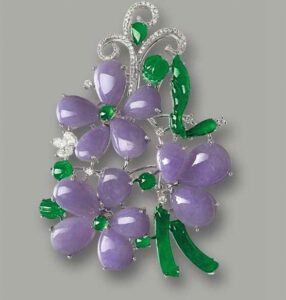
Icy jade Buddha pendant, photo credit Gems & Gemology (GIA, 2014) and Zhaoyi Xintiandi Co. Ltd
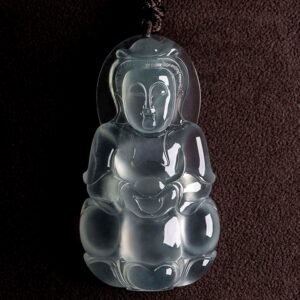
Mawsitsit ring (2016 Spectrum Winner), photo credit Mark Schneider Design
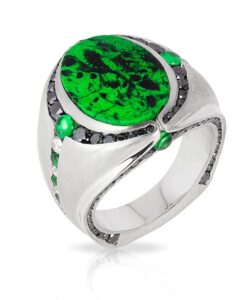
Reticulated jadeite bead necklace, late Qing dynasty, photo credit Wang Collection
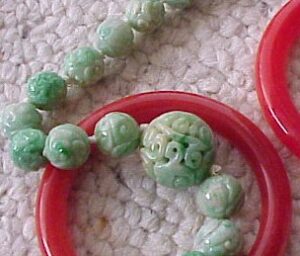
Platinum, jadeite, and diamond brooch, c. 1930, photo credit Sotheby’s
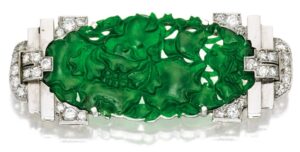
Transcript:
Jade is a popular gemstone that even the most avid jewelry collectors often know little about. Much of the confusion stems from the fact that two distinct stones share the same name. Enter Eric Hoffman, a jade dealer and author who is an expert on identifying different types of jade. He joined the Jewelry Journey Podcast to talk about jadeite jade vs. nephrite jade; why jade can either be extremely valuable or basically worthless; and how new collectors can find quality pieces. Read the episode transcript here.
Sharon: Hello, everyone. Welcome to the Jewelry Journey Podcast. This is the second part of a two-part episode. If you haven’t heard part one, please head to TheJewelryJourney.com. Today, my guest is Eric J. Hoffman, who’s extremely knowledgeable about jade. Eric is the owner of Far East Gallery and HoffmanJade.com. He is a seller and a buyer, and he knows a lot about what makes jade valuable. He’s also an author. Welcome back.
But you said there’s a white jade that’s a nephrite, and then there’s another kind of white jade that’s a jadeite, right?
Eric: That’s right. When you’re talking about white jade, it makes a big difference whether it’s nephrite or jadeite. White nephrite is very desirable. White jadeite is kind of a waste material. In fact, it’s often dyed or polymer-treated to make it look like something it’s not.
Sharon: When you say something it’s not, what do you mean? Is it to try and fool people? Why do carvers value white jade so much?
Eric: Again, you have to distinguish between the two types of white jade. The nephrite is desirable to carvers because it can be carved thin and it’s not going to break on them while they’re carving. The jadeite is generally valued for jewelry, and people don’t want a white stone ring. They want the nice, imperial green, apple green jadeite. Back in the late 80s, around 1989, someone figured out how to polymer treat and dye white jadeite to make it look like the imperial green, desirable jadeite.
Sharon: Wow, there’s a lot to learn when it comes to stone. The white nephrite that’s called jade, when it comes to carving, it’s harder to carve. Am I right?
Eric: All carving is hard, but at least the nephrite’s not going to break on you. It’s not going to crumble. It’s not going to cleave like some minerals like fluorite, for example, might do. There are carvings in jadeite as well. It’s a little less tough and a little bit harder.
Sharon: But jadeite is what was in Burma. Maybe I’m getting confused. I’m trying to keep it straight. When you talk about the Chinese, that’s more of the nephrite jade, and when you talk about the Burmese, that’s more of the jadeite, right?
Eric: In terms of where they come from, but there’s not much of an industry in Burma carving jadeite. The jadeite comes out of the ground in Burma, and it goes immediately to China where it is made into jewelry and carvings and artifacts and so forth.
Sharon: I’m just getting confused. If somebody says to me, “This is a jade bracelet,” and it’s green, what do I ask? Where it came from, or is it nephrite or jadeite? What do I ask?
Eric: The question would be is it nephrite or jadeite. The answer will probably come back that it’s jadeite. When you see jade bangle bracelets, for example, they’re usually but not always jadeite. Usually if it’s a vivid apple green, it’s probably jadeite. If it’s a darker grayish green, it’s probably nephrite.
Sharon: What if it’s white? I’m thinking of a hand-made bangle. If they say it’s white jade, is that just treated jadeite?
Eric: They would probably not stop at white. They would try to dye it or polymer treat it to try to fool you into thinking it’s a more valuable type of jade.
Sharon: So, when somebody says to me, “This is jade,” they really mean jadeite, right? There’s nephrite, but most things are jadeite. I’m just trying to understand this.
Eric: It’s a complicated subject for sure. Most of the jewelry, but not all that you encounter, will be jadeite. There is nephrite jewelry, but it’s probably 10 to one in favor of jadeite.
Sharon: When I was talking to Elyse, she was saying that most of the time the carvings are too large to be used for jewelry, as you were saying, but there are smaller things such as beads and things like that. Is that jade jadeite? Why are they made into small items?
Eric: Jade is found in small quantities, so that’s one thing that limits the size. It’s costly material, at least the higher grades of jadeite. That would be another thing that limits the size.
Sharon: What would icy jade be? Tell us about icy jade.
Eric: That’s another interesting subject. When you’re judging jadeite, you’re looking at the color. You look at what’s called the texture, which is the fineness of the individual, microscopic crystals. It affects the kind of polish the jade can take. You look at the clarity. You’d like to find jade that doesn’t have inclusions or black spots in it. There’s also something called translucence. As jade becomes more and more translucent, you get to where you can almost read text through it. That’s called icy jade.
Sharon: Do you look at whether it’s jade or icy jade? Do you look at it under a microscope to decide if you’re going to buy it or judge it?
Eric: No, you can see right away that it’s an example of icy jade, but it’s fairly rare material. It didn’t used to be worth anything particularly more than other jades until Christie’s, some years ago in a marketing coup, changed the name from water jade to icy jade.
Sharon: Water jade to icy jade.
Eric: And it took off. In the many pieces I’ve handled over the decades, I only have one piece of icy jade.
Sharon: That’s you’ve handled or that you would be willing to part with?
Eric: Both.
Sharon: Putting icy jade aside, when you evaluate a piece of jade, do you look under a microscope at all? Is that part of your process? I don’t know what you look for.
Eric: Generally, no. Generally, a 10x loupe is about all you need to evaluate jade. For example, with a 10x loupe, you can look and see if dye is seeping into the little boundaries between regions on jadeite. The other instrument that is sometimes useful would be a refractometer, which is occasionally brought into play to distinguish between a nephrite and a jadeite.
Sharon: Somebody brought my mother a gift back from China, and she said it was jade. Would that have been an imitation jade? I don’t know what she paid for it. I don’t remember. Was it a jade jadeite versus—I mean, nephrite doesn’t sound like it’s in the picture.
Eric: It could have been any one of those. There are some fairly simple tests of hardness and specific gravity and so forth that you can run to tell what you’re looking at.
Sharon: As a collector and, as you can tell very obviously, somebody who knows nothing about jade or nephrite or Mawsitsit or icy jade, what would you say to a collector just starting out? What should they look for? What should they have with them? I got rid of my refractometer a long time ago. I said, “Forget it. I never use it.” What would they do with it?
Eric: The one thing you should always have with you is a 10x loupe. The other thing you should always have with you is a healthy sense of skepticism. I assume that any ancient jade I’m shown is a brand-new fake until proven otherwise. When you’re shown a gorgeous piece of jade jewelry, you should be a little skeptical as to whether it’s natural or has been treated in some way.
Sharon: Treated meaning coated with color to make it look a different color or a stronger color?
Eric: There have been examples of coating, but I was really referring to was what started back in 1989, with the polymer treatment of pretty much worthless white jadeite.
Sharon: How would I know? How would a collector know?
Eric: It’s a problem. At a certain price level, you would go to the GIA. They would look at your piece with an infrared spectrometer and tell you yes or no, whether it’s natural or colored or had been treated. But this test, of course, costs a few hundred dollars, so you’re probably up in the $20,000-$30,000 price range before it becomes worthwhile doing that.
Sharon: If you’re buying a less expensive piece that’s not a $20,000 piece, what would you say a collector should look for? Should we look for translucency? If they tell me something is old, how do I know?
Eric: If you don’t have a $100,000 spectrometer laying around in your basement, you should probably look for a dealer you can trust who does have access to one, either directly or through a lab like GIA.
Sharon: I can tell you’re on the East Coast if you say a basement, because who knows what a basement is out here? In fact, I did see a house with a basement, and I was floored. I thought a house with a basement in Los Angeles—
Eric: No basements in Los Angeles?
Sharon: No basements out here, or maybe just a few old, old houses. So, what attracts you? Do you like the color of the jade you buy? Whatever you put on your site, do you like it?
Eric: Yes, the colors of nephrite are more subdued and softer and more subtle, but I find them attractive. The colors of jadeite are brighter and a more vivid green. There’s also lavender, which is very attractive. So, yes, the color is one thing, and the extreme toughness of nephrite, what it lets carvers accomplish.
Sharon: If something is lavender, depending on price range, you could add polymers to make it lavender? Is it nephrite or would that be jadeite, or both?
Eric: That is jadeite, yes. Unfortunately, lavender is faked as well. Polymer-treated lavender does exist. It’s usually so garish looking that you can dismiss it right out of hand, but a really good imitation can be a little harder to tell. Once again, you rely on an infrared spectrometer to tell the difference.
Sharon: Do you have one lying around your house?
Eric: I have no infrared spectrometer.
Sharon: In the thousands of years they’ve been carving jade, whether it’s in China or Burma or wherever, is there natural lavender jade? What are the natural colors?
Eric: Oh yes, there is natural lavender. It’s a softer, more subtle lavender. It comes from Burma along with the other jades, so it does exist.
Sharon: Are there any other colors? There’s green; there’s white; there’s lavender. There are different shades of green, but what else? Is that it for all the jades?
Eric: There is a red. There’s a reddish brown, russet and black.
Sharon: And they all come from Burma and then they’re shipped off to China? Or are they in China?
Eric: The jade is all from Burma and it’s almost universally carved in China.
Sharon: So, if somebody shows me a piece—I keep going back to this example of a bangle bracelet—and somebody says it’s from China, it’s really been dug out of the ground in Burma and shipped off to China to be made into something. Is that what you’re saying?
Eric: That’s correct. If it’s jadeite, the raw material came from northern Burma and the work was almost certainly done in China.
Sharon: O.K. You must really take people aback when you start asking them questions. They probably think you’re just another person who doesn’t know anything about jade.
Eric: Once again, you want to find a dealer you have some faith in.
Sharon: Do you think you have those dealers? Because you’re a dealer, do you think the people you get your material and your carved objects from, are they trustworthy? If they call you and say, “Hey, do I have a deal for you,” do you say, “O.K., let me hear about it”?
Eric: There are dealers I buy from and there are dealers I sell to. I also sell jade books, books about jade.
Sharon: Tell us about some of the things you’re written about or the names of the books.
Eric: At one point, I might have been the number one seller of jade books in the world. I’ve written about that. I’ve sent a lot of the best ones to China. Even though the shipping cost can be horrendous for a big, heavy book, it doesn’t seem to bother anybody in China to pay it.
Sharon: You must have clients from all over the world.
Eric: Yeah, I’ve probably shipped to about 20 to 30 countries.
Sharon: Besides the books, who contacts you from all over the world to say, “Hey, I saw this object on your site”?
Eric: I get that all the time, people showing pictures. Invariably it’s imitation ancient jades.
Sharon: How about when they want to buy something from you? Do they come from all over the world?
Eric: I ship all over.
Sharon: Tell us what you’ve written about. If you’re the number one seller, people really trust what you have to say about jade. Are you writing from a mineral perspective for what to look for? What are you telling them? What are you writing about in the books?
Eric: As an engineer, it’s the technical aspect I appreciate the most. Telling jade from pseudo jade has been a side specialty.
Sharon: I shouldn’t send my bracelet from the swap meet to you because I should just assume it’s pseudo jade. That’s what you’re saying, right?
Eric: It pays to have a healthy sense of skepticism. I assume everything is fake until proven otherwise.
Sharon: How would somebody prove otherwise to you? Because it’s old and they’re brushing the dirt off of it? How would they prove it?
Eric: Perhaps the most reliable thing in dealing with ancient jades is to take a close look at the tooling techniques and looking for modern toolmarks, which would not have been used a thousand plus years ago.
Sharon: Do you often find when you’re evaluating a piece for you to buy to resell, will someone tell you, “Oh, this is made with old tools,” and then you’ll find a modern tool mark and hand it back?
Eric: There’s no handing back. A lot of times, you have to buy in a dark, dingy corner, no recourse, no refund, cash only.
Sharon: I guess I’m thinking about a big show or something like that. You’re saying they pull you aside. Do they open their raincoat or something?
Eric: At a big show, of course, the vetting has already been done for you. But that’s reflected in the very high prices, so it’s hard to buy anything at a big show for resale.
Sharon: As a collector, if we were going to buy or evaluate a piece and we don’t have our handy refractometer with us, what should we be doing in terms of the sense of skepticism? It’s like how on Antiques Roadshow you see people all the time who believe they have pre-Columbian artifacts and they’re proven to be fake. Should we look for contemporary toolmarks? Is that one tell?
Eric: You’ve opened another new subject, and that’s pre-Columbian jade. Jade was carved in Central America roughly about the time of the Chinese Zhou Dynasty. In fact, there’s some thought that perhaps there was communication between China and the jade carvers in Central America because a lot of the motifs are the same. But in Central America, at that time, they were using string and abrasives and stone files, not metal tools.
Sharon: When was this?
Eric: This would have been maybe 500 to 1,000 years ago.
Sharon: Not that long ago, really, when you compare it to China or even other places in the world.
Eric: That’s right. For the first several thousand years, China carved with the same kinds of tools before they had metals.
Sharon: That’s really interesting. Tell us a bit more about when we should come to a person like you, what we’ll find in the books and chapters you’ve coauthored. Are we only going to find technical stuff, or are we going to find history? Are we going to find anything else?
Eric: There are jade books that cover all of that. Unfortunately, they’re not all in the same book. The book I worked on most recently was by Richard Hughes in Bangkok. It’s a big, heavy book. It’s costs $200 just to mail it from Bangkok to the United States. It’s not the kind of investment everybody will make, and it does focus on the gemology aspects of both nephrite and jadeite.
Sharon: When are you going to be writing your book about history? You say there’s not a book that encompasses it all. Forget the minerology, but the history, the carving, how it’s done. When are you going to write it?
Eric: I don’t think you should wait for it. I’ve been assembling notes for about 20 years. Elyse asks that same question about once a week.
Sharon: So, I should come back to you in 10, 15 years?
Eric: 10 years would be good.
Sharon: For somebody like me, it would be an easier book to write because I don’t know the technical stuff. The history and the carving would be interesting and fast to write.
Eric: While you’re waiting the 10 years, there is actually a book that was written called “Jade Lore.” I’m not sure when it was written; possibly in the 40s. That does cover, in a very readable way, a lot of the history along with a little bit of the technical.
Sharon: But isn’t it out of print because it’s been so long?
Eric: It’s out of print, but you can find copies. It was written by a journalist who was on-site in China around the time the Qing Dynasty was falling apart, and a lot of these pieces were coming onto the market.
Sharon: When was that? How long ago?
Eric: The Qing Dynasty fell in 1911, 1912. I think this book was written either in the 30s or 40s. It was written by somebody who really knew how to write a lively story.
Sharon: Where have you been? If you’re saying you look at these objects or jewels, have you been to some of the places and seen them directly, or is it mostly when somebody brings you into a dark corner?
Eric: I’ve been to Taiwan. I have not been to mainland China. As I mentioned earlier, the Chinese really want to repatriate and bring back into the country the best jades as well as jade books. To get pieces of jade now, you pretty much have to stumble across American collections or European collections.
Sharon: I think that’s true of other pieces too. It seems that the Chinese are very interested in repatriating a lot of older jewelry. We’re being told they’re the ones who drive the prices up. Is that also true in jade?
Eric: Oh, absolutely. In fact, there’s a book on that subject as well.
Sharon: Which is?
Eric: On the whole subject of repatriating these pieces back into China.
Sharon: What do people do with them when they have them back in China?
Eric: What do they do with them in China?
Sharon: Yeah.
Eric: Some of those will end up in museums in China. Others end up in private collections of millionaires.
Sharon: Eric, I see Elyse in the corner there. You have to go pack your bags so you can get ready for your next trip to Myanmar or mainland China. You’ve been to Taiwan. Thank you very much for being with us today.
Eric: It’s a pleasure. Thank you for inviting me.
Sharon: It’s been great. We will have photos posted on the website. Please head to TheJewelryJourney.com to check them out.
Thank you again for listening. Please leave us a rating and review so we can help others start their own jewelry journey.

